Top speed 2,440 km/h Wingspan 8.22 m First flight 1973 | Length 16 m Introduced 1975 | |
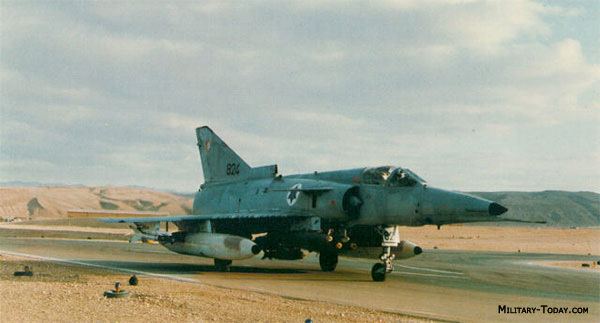 | ||
Engine types Turbojet, General Electric J79 | ||
The Israel Aircraft Industries Kfir (Hebrew: כְּפִיר, "Lion Cub") is an Israeli-built all-weather, multirole combat aircraft based on a modified French Dassault Mirage 5 airframe, with Israeli avionics and an Israeli-built version of the General Electric J79 turbojet engine.
Contents
- Israel aircraft industries iai lavi
- Background
- Design
- Operational history
- The Kfir in foreign service
- United States
- Colombia
- Ecuador
- Sri Lanka
- Potential users
- Variants
- Current
- Former
- Specifications Kfir C2
- References
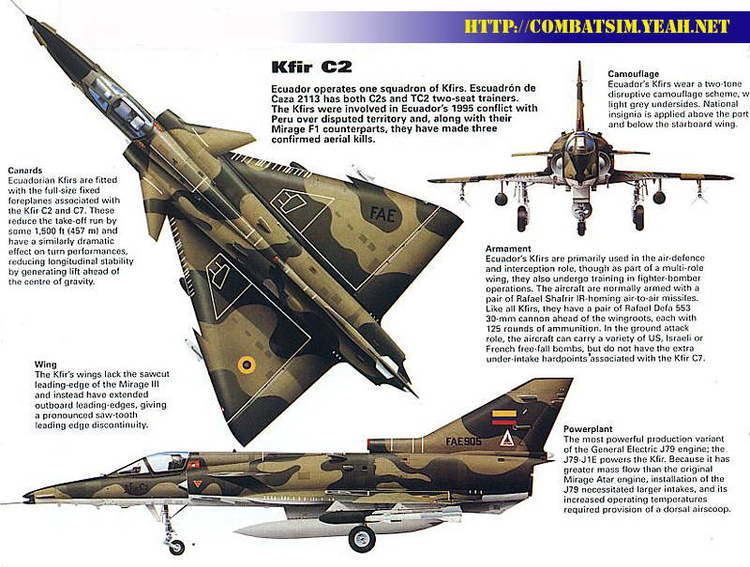
Israel aircraft industries iai lavi
Background
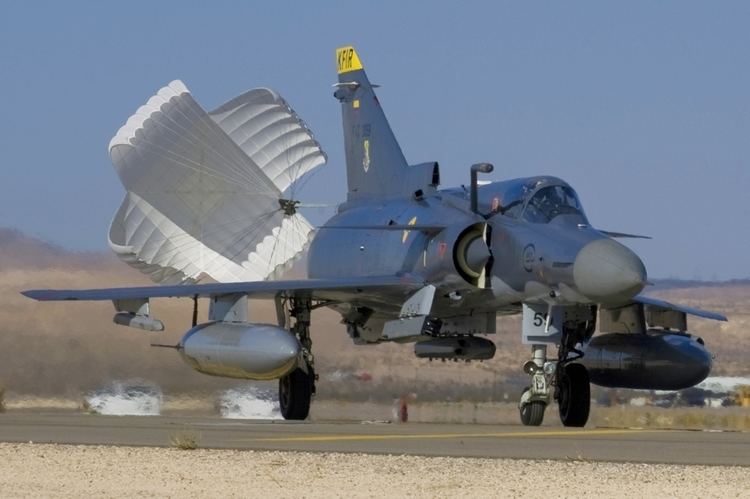
The project that would ultimately give birth to the Kfir can be traced back to Israel's need for adapting the Dassault Mirage IIIC to the specific requirements of the Israeli Air Force (IAF).
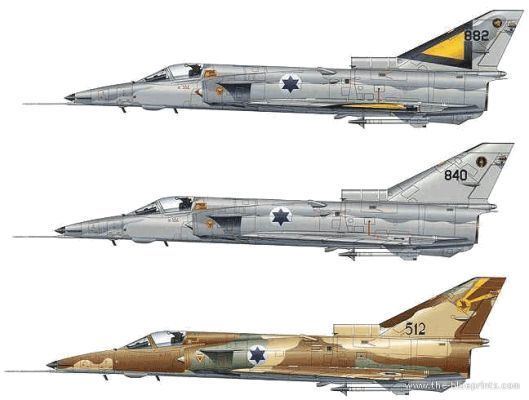
The all-weather, delta-winged Mirage IIICJ was the first Mach 2 aircraft acquired by Israel from then close ally France, and constituted the backbone of the IAF during most of the 1960s, until the arrival of the Douglas A-4 Skyhawk and, most importantly, the McDonnell Douglas F-4 Phantom II, by the end of the decade. While the Mirage IIICJ proved to be extremely effective in the air-superiority role, its relatively short range of action imposed some limitations on its usefulness as a ground-attack aircraft.
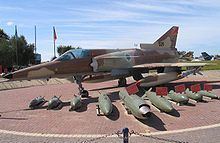
Thus, in the mid-1960s, at the request of Israel, Dassault Aviation began developing the Mirage 5, a fair-weather, ground-attack version of the Mirage III. Following the suggestions made by the Israelis, advanced avionics located behind the cockpit were removed, allowing the aircraft to increase its fuel-carrying capacity while reducing maintenance costs.
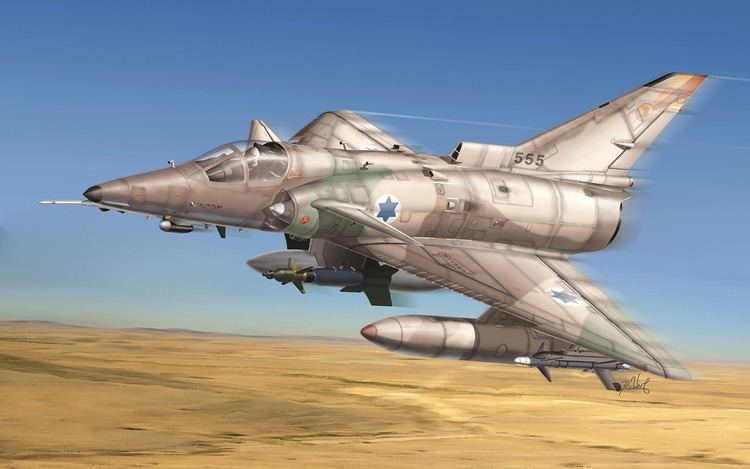
By 1968, Dassault had finished production of the 50 Mirage 5Js paid for by Israel, but an arms embargo imposed upon Israel by the French government in 1967 prevented deliveries from taking place. The Israelis replied by producing an unlicensed copy of the Mirage 5, the Nesher, with technical specifications for both the airframe and the engine obtained by Israeli spies. Some sources claim Israel received 50 Mirage 5s in crates from French Air Force (AdA), while the AdA took over the 50 aircraft originally intended for Israel.
Design

The Kfir programme originated in the quest to develop a more capable version of the IAI Nesher, which was already in series production. After General De Gaulle embargoed the sale of arms to Israel, the IAF feared that it might lose qualitative superiority over its adversaries in the future, which were receiving increasingly advanced Soviet aircraft. The main and most advanced type of aircraft available to the IAF was the Mirage, but a severe problem developed due to the Mirage fleet's depletion due to attrition after the Six-Day War. Domestic production would avoid the problem of the embargo completely; efforts to reverse engineer and reproduce components of the Mirage were aided by Israeli espionage efforts to obtain technical assistance and blueprints from third party Mirage operators.
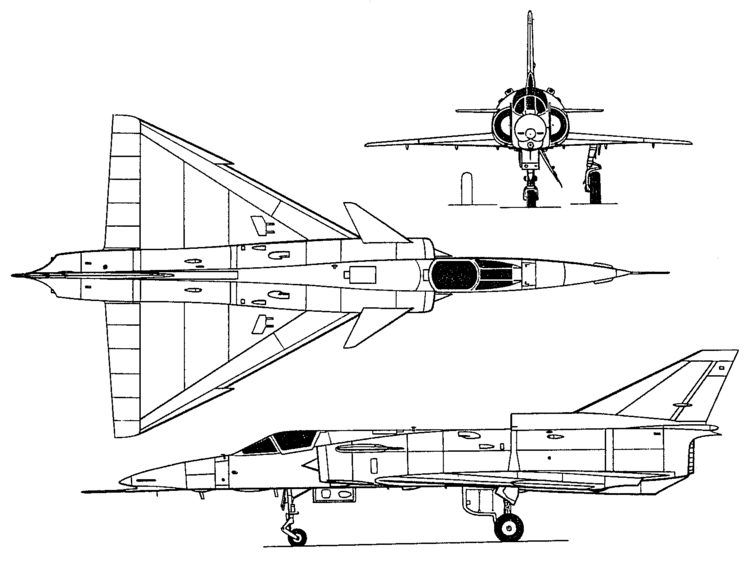
Two powerplants were initially selected for trials, the General Electric J79 turbojet and the Rolls-Royce Spey turbofan. In the end, the J79 was selected, not least because it was the same engine used on the McDonnell Douglas F-4 Phantom II, which the Israelis began to acquire from the United States in 1969, along with a license to produce the J79 themselves. The J79 was clearly superior to the original French Atar 09, providing a dry thrust of 49 kN (11,000 lbf) and an afterburning thrust of 83.4 kN (18,750 lbf).
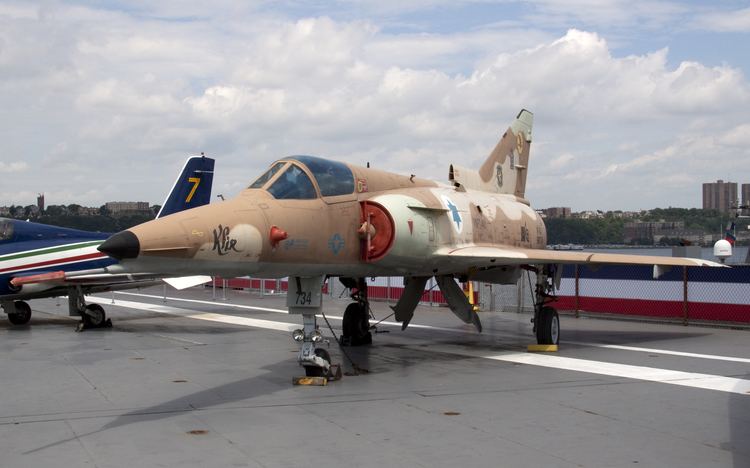
In order to accommodate the new powerplant on the Mirage III's airframe, and to deliver the added cooling required by the J79, the aircraft's rear fuselage was slightly shortened and widened, its air intakes were enlarged, and a large air inlet was installed at the base of the vertical stabilizer, so as to supply the extra cooling needed for the afterburner. The engine itself was encased in a titanium heatshield.
A two-seat Mirage IIIBJ fitted with the GE J79 made its first flight in September 1970, and was soon followed by a re-engined Nesher, which flew in September 1971.
An improved prototype of the aircraft, with the name Ra'am B ("Ra'am" means "Thunder"; the "Ra'am A" was the Nesher), made its first flight in June 1973. It had an extensively revised cockpit, a strengthened landing gear, and a considerable amount of Israeli-built avionics. The internal fuel tanks were slightly rearranged, their total capacity being increased to 713 US gal (2,700 l).
There were unconfirmed reports that a number of the original Mirage IIICs, re-engined with the J79 and given the name Barak ("Lightning"), took part in the Yom Kippur War of 1973, but some sources point out that there is no evidence that these aircraft ever existed.
Operational history
The Kfir entered service with the IAF in 1975, the first units being assigned to the 101st "First Fighter" Squadron. Over the following years, several other squadrons were also equipped with the new aircraft. The role of the Kfir as the IAF's primary air superiority asset was short-lived, as the first F-15 Eagle fighters from the United States were delivered to Israel in 1976.
The Kfir's first recorded combat action took place on November 9, 1977, during an Israeli air strike on a training camp at Tel Azia, in Lebanon. The only air victory claimed by a Kfir during its service with the IAF occurred on June 27, 1979 when a Kfir C.2 shot down a Syrian MiG-21.
By the time of the Israeli invasion of southern Lebanon in 1982 (Operation Peace for Galilee) the IAF was able to use both its F-15s and F-16s for air superiority roles, leaving the Kfirs to carry out unescorted strike missions. Shortly afterwards, all IAF C.2s began to be upgraded to the C.7 version, with enhanced weight performance, making the Kfir more suitable to its new fighter-bomber role. During the second half of the 1990s, the Kfirs were withdrawn from active duty in the IAF, after almost twenty years of continuous service.
Israel Aerospace Industries announced in August 2013 it will offer pre-owned Kfir fighter jets to foreign customers, with a 40-year guarantee. Unit price is reported to be $20 million. A few Eastern European and Latin American countries have expressed interest, Israel’s Globes business daily reported. By October 2013, Israel Aerospace Industries was in "very advanced negotiations" with at least two air forces interested in the Kfir Block 60. An aircraft can be delivered within one year, with two squadrons to be sold in two to three years. The Block 60 is offered with the Elta EL/M-2032 with open architecture avionics to allow a customer to install other systems. The sensor provides an all-aspect, look-down/shoot-down performance in air-to-air and air-to-ground missions, with the capability to simultaneously track up to 64 targets. The J79 has been overhauled to zero flight hours, and would need replacement after 1,600 hours.
The Kfir in foreign service
Since the J79 turbojet engine is a U.S design, although made in Israel, all export sales of the Kfir are subject to prior approval from the U.S. State Department, a fact that has limited the sale of the Kfir to foreign nations.
As of 2006, the IAI KFIR has been exported to Colombia, Ecuador, and Sri Lanka.
United States
Between 1985 and 1989, the United States Navy and United States Marine Corps leased 25 examples of the Kfir C.1, which were officially designated F-21A and modified for use as unarmed adversaries: mock opponents in dissimilar air combat training (DACT). These aircraft had narrow-span canard foreplanes and a single small rectangular strake on either side of the nose which considerably improved the aircraft's maneuverability and handling at low speeds.
The 12 F-21 aircraft leased to the U.S. Navy, painted in a three-tone blue-gray "ghost" scheme, were operated by Fighter Squadron 43 (VF-43), based at NAS Oceana, Virginia. In 1988, they were returned and replaced by the F-16N. The 13 aircraft leased to the U.S. Marine Corps were operated by Marine Fighter Training Squadron 401 (VMFT-401), a 4th Marine Aircraft Wing/Marine Corps Reserve squadron at Marine Corps Air Station Yuma, Arizona. In addition to the blue-gray painted aircraft, the USMC also had some F-21s painted in Israeli colors and desert "flogger" schemes (named because they were to represent the schemes often worn by Warsaw Pact MiG-23 "Floggers"). The Kfir was utilized because they both shared the common characteristic of being very fast (Mach 2+) and fast-accelerating aircraft with relatively poor maneuverability. The MiG-23 was targeted as the "enemy" aircraft because at this time the MiG-23 was being introduced in very large numbers, and was a very capable aircraft compared to earlier Soviet types. These USMC F-21 aircraft were replaced by F-5E aircraft when the F-21s were returned in 1989 (although this left the training units without any aircraft capable of accurately simulating the Mach 2+ and fast-accelerating MiG-23).
Six Kfirs are also used by the US firm Airborne Tactical Advantage Company (ATAC), a civilian defense contractor that provides tactical adversary aircraft services to the US military. ATAC provides airborne tactical training, threat simulation, and research & development. ATAC's corporate headquarters and primary operating location is located at Patrick Henry International Airport in Newport News, VA, with additional permanent operating locations at US Naval Air Stations and Marine Corps Air Stations in California, Nevada, Hawaii and Japan. ATAC also operates Hawker Hunter F.58s. On March 6, 2012, an ATAC Kfir, FAA registration N404AX, crashed while landing at NAS Fallon, Nevada after a flight supporting the Naval Strike and Air Warfare Center. The pilot, retired USN Captain Carroll "Lex" LeFon, was fatally injured.
Colombia
As a result of a trade agreement between Colombia and Israel in 1989 the Colombian government bought a batch of 12 ex-IAF Kfir C.2s and one TC.2, which were delivered to the Colombian Air Force (FAC) in 1989–1990. Since then, all the C.2s have been upgraded to the C.7 variant. The FAC Kfirs have been widely used in ground-attack missions during counter-insurgency operations against Colombian terrorists. Colombian Kfirs are armed with Python 3 IR-homing AAMs. As of 2004 two aircraft had been lost in accidents.
In February 2008, Colombia signed a deal with the Israeli government for an additional 24 ex-IAF Kfir aircraft. It was estimated that these aircraft will most probably be upgraded by Israel Aerospace Industries to C.10 standard.
In June 2009, IAI delivered the first batch of upgraded Kfirs to the Colombian Air Force in a ceremony held at IAI's facilities in Israel. In attendance at the ceremony was Juan Hurtado Cano, the Colombian Ambassador to Israel, high-ranking officers from the Colombian Air Force, and executives from the Israeli Ministry of Defense (IMOD-SIBAT). This was a part of a multi-year contract awarded in late 2007 and worth over $150 million to upgrade the existing Colombian Air Force Kfirs, and to supply additional jets. The additional Kfir jets, models C.10-C.12, have been upgraded and improved to include IAI's latest technologies and products.
On July 20, 2009, a Kfir crashed near the city of Cartagena. The Israeli pilots operating the plane were unharmed in the incident, but the jet itself was destroyed. Israel Aerospace Industries said in a statement that the plane was flying a refresher flight, and that the aircraft didn't come to a stop on the landing strip, landing outside it. The director of the Israel Aerospace Industries announced that an investigation into the incident had already begun and that a panel to probe the crash had been appointed.
On July 22, 2009, Israel Aerospace Industries informed the Colombian Air Force that the accident was caused by an unspecified human error. As a result, Israel Aerospace Industries will replace the unit lost with another one and it will resume delivery to the Colombian Air Force.
On November 1, 2013, two Colombian Air Force IAI Kfirs intercepted Russian Air Force Tu-160s that had entered Colombian airspace. The Russian aircraft had taken off from Simón Bolívar International Airport Venezuela.
Ecuador
In 1981, Ecuador and Israel signed a sales agreement for ten refurbished ex-IAF Kfir C.2s and two TC.2s, which were delivered to the Ecuadorian Air Force (FAE) in 1982–1983. The Kfirs formed the 2113rd Squadron (Lions) of the FAE's 21st Fighter Wing, based at Taura AFB, on the Ecuadorian western lowlands.
The FAE Kfirs went into action during the 1995 Cenepa War between Ecuador and Peru. Relying on its fleet of subsonic A-37Bs for low-level ground-attack missions on Peruvian positions, the Ecuadorian Air Force held back its Mirage F.1s and Kfir C.2s for use as escorts and interceptors. On February 10, 1995, a Kfir C.2 shot down a Peruvian Air Force Cessna A-37B with a Shafrir 2 IR-homing AAM.
In 1996, with tensions still running high between Ecuador and Peru, the Ecuadorians acquired four additional Kfirs (three C.2 and one TC.2) after securing approval from the U.S. State Department.
In 1998, with its aging squadron of SEPECAT Jaguar fighter-bombers about to be withdrawn from active duty, Ecuador began talks with Israel for the sale of a new batch of eight Kfirs. Fearing an escalation of the arms race in South America (Peru had recently acquired 18 MiG-29s and 18 Su-25s from Belarus), the United States blocked the deal. As an alternative, Ecuador and Israel signed an agreement in 1999 for the delivery of two Kfir C.10s and for the conversion of an undisclosed number of the FAE's original C.2s to the C.10 version, referred to in Ecuador as Kfir CE, featuring a Helmet Mounted Display System, and armed with Python 3 and Python 4 IR-homing AAMs.
By 2005, Ecuador had lost four Kfirs, including one TC.2, due to accidents since the aircraft entered service in 1982.
Sri Lanka
The Sri Lanka Air Force (SLAF) acquired six Kfir C.2s and a single TC.2 in 1995–1996. A further nine aircraft had been added to the inventory by 2005, including four C.2s and four C.7s acquired in 2000. Currently the SLAF operates two TC.2s, two C.7s and six C.2s by the No. 10 "Fighter" Squadron. The SLAF used their Kfirs to carry out attacks against LTTE rebels during the Sri Lankan Civil War in Sri Lanka. Two Kfir C.7s were destroyed on the ground in an LTTE attack on SLAF Katunayake air base, part of Bandaranaike International Airport, on 24 July 2001. Three others were lost in non-combat related accidents during the Civil War period. None were lost in aerial combat. In March 2011, two Kfirs collided in mid-air during an airshow practice sortie.
Potential users
In the early 1990s, IAI was looking to export 40 Kfir-C fighters to Taiwan in a deal estimated to have been worth US$400 million to $1 billion; the deal fell through.
In 2013, the Argentine Air Force commenced negotiations with Israel for 18 Kfir Block 60 fighters as an alternative to another deal for 16 ex-Spanish Mirage F1 fighters. Industry sources claim IAI will "soon" receive an order for the Argentine Air Force for Kfir Block 60s after their purchase of surplus Spanish Mirage F1s failed.
Variants
Current
Former
Kfirs also doubled as MiGs in the 1985 Tristar Pictures movie Iron Eagle.
Specifications (Kfir C.2)
Data from Jane's All The World's Aircraft 1982–83.
General characteristics
Performance
Armament
